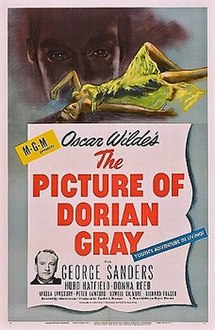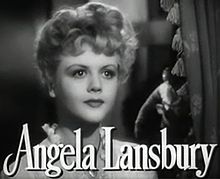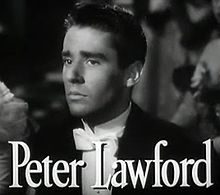The Picture of Dorian Gray (1945 film)
| The Picture of Dorian Gray | |
|---|---|
 Promotional poster | |
| Directed by | Albert Lewin |
| Screenplay by | Albert Lewin |
| Based on | The Picture of Dorian Gray by Oscar Wilde |
| Produced by | Pandro S. Berman |
| Starring | George Sanders Hurd Hatfield Donna Reed Angela Lansbury Peter Lawford |
| Narrated by | Cedric Hardwicke |
| Cinematography | Harry Stradling |
| Edited by | Ferris Webster |
| Music by | Herbert Stothart |
| Color process | Technicolor |
Production company | |
| Distributed by | Loew's Inc. |
Release date | March 3, 1945[1] |
Running time | 110 minutes[2] |
| Country | United States |
| Language | English |
| Budget | $1,918,000[3] |
| Box office | $2,975,000[3][4] |
The Picture of Dorian Gray is a 1945 American horror-drama film based on Oscar Wilde's 1890 novel of the same name. Released in June 1945 by Metro-Goldwyn-Mayer, the film is directed by Albert Lewin and stars George Sanders as Lord Henry Wotton and Hurd Hatfield as Dorian Gray. Shot primarily in black-and-white, the film features four colour inserts in 3-strip Technicolor of Dorian's portrait; these are a special effect, the first two inserts picturing a youthful Dorian and the second two a degenerate one.
Plot[]
London, 1886. Dorian Gray is a handsome and wealthy young man. While generally intelligent, he is naive and easily manipulated. These faults lead to his spiral into sin and ultimate misery.
While posing for a painting by his friend Basil Hallward, Gray meets Hallward's friend Lord Henry Wotton. The cynical but witty Wotton persuades Gray the only worthwhile life is dedicated to pleasure, because "what the gods give they quickly take away." After Wotton convinces Gray that youth and beauty will bring him everything he desires, Dorian wishes his portrait could age instead of him. He makes the wish in the presence of an Egyptian cat statue with supposed mystical powers.

Dorian visits a tavern, where he falls in love with a beautiful singer named Sibyl Vane. They begin a romance, despite disapproval from Sibyl's brother James, and they are soon engaged. Though initially contented, Dorian is again persuaded by Lord Henry to pursue a more hedonistic lifestyle. Dorian sends Sibyl a hurtful letter, ending their relationship and "compensating" her with a large payment in cash.
The next morning, Dorian finds his own face unchanged but the portrait has changed and "the lines of cruelty about the mouth were unmistakable." He starts to realize his wish to the cat may be real. Lord Henry arrives with news that a heartbroken Sibyl killed herself the previous night, after receiving Dorian's letter. Dorian is at first shocked and guilty but soon adopts Lord Henry's indifferent manner. He surprises Hallward by going to the opera that evening. Dorian has the portrait locked away in his old school room and disguises its location by firing servants who moved the painting. He becomes ever more dedicated to a sinful and heartless life.


Years later, Dorian is forty but looks twenty-two, unchanged from when Hallward painted the portrait. London society is awestruck at his unchanging appearance. Over eighteen years of debauchery, the portrait has remained locked away, with Dorian holding the only key. Dorian has become paranoid no others see the portrait and he repeatedly fires servants who are too inquisitive. Over the years, the portrait of the young, handsome, Dorian has warped into a hideous, demon-like creature reflecting Dorian's sins. Artist Hallward eventually sees his painting; shocked at its disfigurement, scarred "as if some moral leprosy was eating him away", Hallward encourages Dorian to reform his life. However, Dorian panics, murders his friend and seals his body in the school room next to the portrait.
Dorian blackmails an old doctor friend, Allen Campbell, to dispose of Hallward's body. He then starts a romance with Hallward's niece, Gladys, who was a child when the portrait was painted. Though Gladys had always loved Dorian, and is overjoyed when he proposes marriage, those close to Dorian find him suspicious and changed. Campbell, distraught at his role in destroying Hallward's corpse, commits suicide.
Dorian begins to realise the harm he inflicts on himself and others. He is accosted by James Vane, Sibyl's brother, who has sworn revenge for his sister's death. Dorian, abusing his ever youthful appearance, deceives James by claiming his appearance is too youthful versus the man from eighteen years before. However, James soon learns the truth, following Dorian to his country estate to achieve his revenge. The unfortunate James, hiding in bushes, is shot by accident during a hunting party. Dorian despairs at his impact on others, knowing his role in yet another death and realises he can spare Gladys from misfortune by leaving her.
After sending Gladys a letter breaking their engagement, Dorian confronts his portrait and sees a subtle improvement. Attributing the change to his determination not to harm Gladys he resolves to change his life. However, he also resolves to destroy the portrait. He stabs the portrait in the heart, seeking to end the spell, but cries out as if he too has also been stabbed. His friends, realising what has happened, burst into the schoolroom to discover Dorian dead next to the portrait, his body "withered, wrinkled, and loathsome of visage", now reflecting his sins in physical form. The portrait, by contrast, once more shows Dorian Gray as a young, innocent man.
Cast[]
- George Sanders as Lord Henry Wotton
- Hurd Hatfield as Dorian Gray
- Donna Reed as Gladys Hallward
- Angela Lansbury as Sibyl Vane
- Peter Lawford as David Stone
- Lowell Gilmore as Basil Hallward
- Richard Fraser as James Vane
- Douglas Walton as Allen Campbell
- Morton Lowry as Adrian Singleton
- Miles Mander as Sir Robert Bentley
- Lydia Bilbrook as Mrs. Vane
- Mary Forbes as Lady Agatha
- Robert Greig as Sir Thomas
- Moyna Macgill as Duchess
- Anita Sharp-Bolster as Lady Harborough
- Billy Bevan as Malvolio Jones
- Lilian Bond as Kate
Uncredited Cast
- Cedric Hardwicke as Narrator
- Mitchell Lewis as Waiter
- Reginald Owen as Lord George Farmour
The paintings of Dorian Gray[]

| External audio | |
|---|---|
Two paintings of the character Dorian Gray were used in the film. The painting titled Picture of Dorian Gray[5] used at the end of the film was painted on commission during the making of the film in 1943-1944 by Ivan Le Lorraine Albright, an American artist who was well known as a painter of the macabre. Created specifically for use in the film, it is now part of the art collection of the Art Institute of Chicago. Albright had to paint the picture while the movie was being made in order to show Dorian Gray's physical transformation as his evil actions changed him into a horrid image in the painting, while his actual physical appearance remained that of a young man. At the film's climax, Gray "killed" the painting by piercing it through its heart with a knife, thus killing himself when his physical appearance changed to that of the painting.
The portrait of Dorian Gray seen in the beginning of the film was painted by Henrique Medina and is titled Portrait of Hurd Hatfield as Dorian Gray. It was originally sold at an MGM auction in 1970 when the contents of the studio were sold at a series of auctions lasting several months. It was then sold in a Butterfield and Butterfield Entertainment Memorabilia auction in 1997 for $17,250,[6] and in 2015 it was sold at Christie's, New York for $149,000 and is believed to be in a private collection.[7][8]
Music[]
The first piano piece played by Dorian to Sibyl is Frédéric Chopin's Prelude No 24 in D minor. Played later in the Blue Gate Field house is Ludwig van Beethoven's Moonlight Sonata.
Box office[]
According to MGM records, the film earned $1,399,000 in the U.S. and Canada and $1,576,000 elsewhere, resulting in a loss of $26,000.[3]
Awards and nominations[]
This section needs additional citations for verification. (November 2016) |
| Year | Award | Result | Category | Recipient |
|---|---|---|---|---|
| 1946 | Academy Award | Nominated | Best Art Direction-Interior Decoration, Black-and-White | John Bonar, Cedric Gibbons, Hugh Hunt, Hans Peters and Edwin B. Willis |
| Nominated | Best Actress in a Supporting Role | Angela Lansbury | ||
| Won | Best Cinematography, Black-and-White | Harry Stradling[a] | ||
| Golden Globe Award | Won | Best Supporting Actress | Angela Lansbury | |
| 1996 | Hugo Award | Won | Best Dramatic Presentation | Albert Lewin, Oscar Wilde |
| 2009 | Saturn Award | Nominated | Best DVD Classic Film Release | The Picture of Dorian Gray |
- AFI's 100 Years...100 Thrills – No. 86
- AFI's 100 Years...100 Heroes and Villains:
- Dorian Gray — Nominated Villain
See also[]
Notes[]
References[]
- ^ "The Picture of Dorian Gray (1945)", catalog, American Film Institute (AFI), Los Angeles, California. Retrieved November 5, 2020.
- ^ "THE PICTURE OF DORIAN GRAY (A)". British Board of Film Classification. 1945-04-04. Retrieved 2013-01-27.
- ^ Jump up to: a b c The Eddie Mannix Ledger, Los Angeles: Margaret Herrick Library, Center for Motion Picture Study.
- ^ Scott Eyman, Lion of Hollywood: The Life and Legend of Louis B. Mayer, Robson, 2005 p 337
- ^ Information about Picture of Dorian Gray in the Art Institute of Chicago
- ^ Tribune, Danielle Arnet Special to the. "MERGER MANIA HITS THE AUCTION CIRCUIT". chicagotribune.com. Retrieved 2020-05-13.
- ^ "Lot 1330 Henrique Medina (1901-1988) Portrait of Hurd Hatfield as Dorian Gray". Christie's. 21 March 2015. Retrieved 12 November 2018.
- ^ "Henrique Medina, Cindy Sherman | "Portrait of Hurd Hatfield as Dorian Gray" and "The Evil Twin" (1945 and 2016) | Artsy". www.artsy.net. Retrieved 2020-05-13.
- ^ Vieira, Mark A. (2003). Hollywood Horror: From Gothic to Cosmic. New York: Harry N. Abrams, Inc. p. 117. ISBN 0-8109-4535-5.
External links[]
| Wikimedia Commons has media related to The Picture of Dorian Gray (film). |
- English-language films
- 1945 films
- 1945 drama films
- 1945 horror films
- 1940s fantasy films
- 1940s historical horror films
- American films
- American black-and-white films
- American drama films
- American historical films
- American supernatural horror films
- Films based on The Picture of Dorian Gray
- Films directed by Albert Lewin
- Films featuring a Best Supporting Actress Golden Globe-winning performance
- Films produced by Pandro S. Berman
- Films set in London
- Films set in 1886
- Films set in the 1890s
- Films partially in color
- Films whose cinematographer won the Best Cinematography Academy Award
- Metro-Goldwyn-Mayer films
- Films scored by Herbert Stothart
- Historical fantasy films
